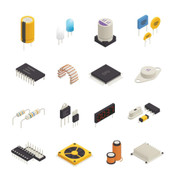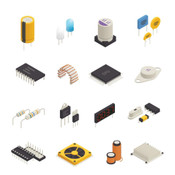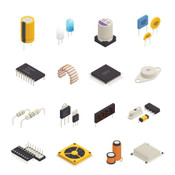Microchip Technology
ATSAME70N20B-CNT
- MPN:
- ATSAME70N20B-CNT
- Condition:
- New
- Availability:
- Will Be Shipped in 7-10 days
- Minimum Purchase:
- 4000 units
Description
The Microchip SAME70N20 devices are members of a flash microcontrollers family based on the high-performance 32-bit ARM Cortex-M7 processor with Floating Point Unit (FPU). These devices operate at up to 300MHz and feature up to 1024 Kbytes of Flash, up to 384 Kbytes of multi-port SRAM and configurable Instruction and Data Tightly Couple Memories to leverage the advanced DSP capabilities of the core. SAME70N20 features multiple networking/connectivity peripherals, including CAN-FD interface and one 1O/100Mbps Ethernet MAC with specific hardware support for Audio Video Bridging (AVB). Additional communication interfaces include a HS USB Host and Device, a HS SDCard/SDIO/MMC interface, USARTs, SPIs and multiple TWIs. Analog features includes dual 2Msps, 12-bit ADCs with analog front end offering offset and gain error correction, and 2Msps 12-bit DAC.
Product Features
- Single- and double-precision HW Floating Point Unit (FPU)
- Memory Protection Unit (MPU) with 16 zones
- DSP Instructions, Thumb®-2 Instruction Set
- Embedded Trace Module (ETM) with instruction trace stream, including Trace Port Interface Unit (TPIU)
- 1024 Kbytes embedded Flash with unique identifier and user signature for user-defined data
- 384 Kbytes embedded Multi-port SRAM
- Tightly Coupled Memory (TCM) interface with four configurations (disabled, 2 x 32 Kbytes, 2 x 64 Kbytes, 2 x 128 Kbytes)
- 16 Kbytes ROM with embedded Bootloader routines (UART0, USB) and IAP routines
- 16-bit Static Memory Controller (SMC) with support for SRAM, PSRAM, LCD module, NOR and NAND Flash with on-the-fly scrambling
- Embedded voltage regulator for single-supply operation
- Power-on-Reset (POR), Brown-out Detector (BOD) and Dual Watchdog for safe operation
- Quartz or ceramic resonator oscillators: 3 to 20 MHz main oscillator with failure detection, 12 MHz or 16 MHz needed for USB operations. Optional low-power 32.768 kHz for RTC or device clock
- RTC with Gregorian calendar mode, waveform generation in low-power modes
- RTC counter calibration circuitry compensates for 32.768 kHz crystal frequency variations
- 32-bit low-power Real-time Timer (RTT)
- High-precision Main RC oscillator with 12 MHz default frequency for device startup. In-application trimming access for frequency adjustment. 8/12 MHz are factory-trimmed.
- 32.768 kHz crystal oscillator or Slow RC oscillator as source of low-power mode device clock (SLCK)
- One 500 MHz PLL for system clock, one 480 MHz PLL for USB high-speed operations
- Temperature Sensor
- One dual-port 24-channel central DMA Controller (XDMAC)
- Low-power Sleep, Wait and Backup modes, with typical power consumption down to 1.1 μA in Backup mode with RTC, RTT and wakeup logic enabled
- Ultra-low-power RTC and RTT
- 1 Kbyte of backup RAM (BRAM) with dedicated regulator
- One Ethernet MAC (GMAC) 10/100 Mbps in MII mode and RMII with dedicated DMA. IEEE1588 PTP frames and 802.3az Energy-efficiency support. Ethernet AVB support with IEEE802.1AS Timestamping and IEEE802.1Qav credit-based traffic-shaping hardware support
- USB 2.0 Device/Mini Host High-speed (USBHS) at 480 Mbps, 4-Kbyte FIFO, up to 10 bidirectional endpoints, dedicated DMA
- 12-bit ITU-R BT. 601/656 Image Sensor Interface (ISI)
- ISO CAN FD; ISO 1189801:2015 (Revision B only)
- Three USARTs. USART0/1/2 support LIN mode, ISO7816, IrDA®, RS-485, SPI, Manchester and Modem modes; USART1 supports LON mode.
- Five 2-wire UARTs with SleepWalking™ support
- Three Two-Wire Interfaces (TWIHS) (I2C-compatible) with SleepWalking™ support
- Quad I/O Serial Peripheral Interface (QSPI) interfacing up to 256 MB Flash and with eXecute-In-Place and on-the-fly scrambling
- Two Serial Peripheral Interfaces (SPI)
- One Serial Synchronous Controller (SSC) with I2S and TDM support
- Two Inter-IC Sound Controllers (I2SC)
- One High-speed Multimedia Card Interface (HSMCI) (SDIO/SD Card/e.MMC)
- Four Three-Channel 16-bit Timer/Counters (TC) with Capture, Waveform, Compare and PWM modes, constant on time. Quadrature decoder logic and 2-bit Gray Up/Down Counter for stepper motor
- Two 4-channel 16-bit PWMs with complementary outputs, Dead Time Generator and eight fault inputs per PWM for motor control, two external triggers to manage power factor correction (PFC), DC-DC and lighting control.
- Two Analog Front-End Controllers (AFEC), each supporting up to 12 channels with differential input mode and programmable gain stage, allowing dual sample-and-hold at up to 1.7 Msps. Offset and gain error correction feature.
- One 2-channel 12-bit 1 Msps-per-channel Digital-to-Analog Controller (DAC) with Differential and Over Sampling modes
- One Analog Comparator Controller (ACC) with flexible input selection, selectable input hysteresis
- True Random Number Generator (TRNG)
- AES: 256-, 192-, 128-bit Key Algorithm, Compliant with FIPS PUB-197 Specifications
- Integrity Check Monitor (ICM). Supports Secure Hash Algorithm SHA1, SHA224 and SHA256.
- Up to 114 I/O lines with external interrupt capability (edge- or level-sensitivity), debouncing, glitch filtering and On-die Series Resistor Termination
- Five Parallel Input/output Controllers (PIO)
- Single Supply voltage from 1.7V to 3.6V for Industrial Temperature Devices
- LQFP100, 100-lead LQFP, 14 x 14 mm, pitch 0.5 mm
- TFBGA100, 100-ball TFBGA, 9 x 9 mm, pitch 0.8 mm









